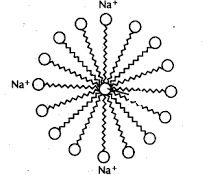
The soap molecule has:
(A) hydrophilic head and a hydrophobic tail
(B) hydrophobic head and a hydrophilic tail
(C) hydrophobic head and a hydrophobic tail
(D) hydrophilic head and a hydrophilic tail
Answer
473.7k+ views
Hint: Soaps are the sodium and potassium salts of fatty acids. Their one of the major applications is the cleansing action of soap based on the principle of micelle formation. Soaps have relatively weak cleansing action in comparison with detergents.
Complete step by step solution:
We have been asked about the soap molecule,
The molecule of soap constitutes sodium or potassium salts of long-chain carboxylic acid.
They are used in the cleansing action,
Sodium stearate is an example of soap with molecular formula: ${C_ {18}} {H_ {35}} Na{O_2} $,

In the case of soaps, the carbon chain dissolves in oil and the ionic end dissolves in water.
Soaps in the form of micelles clean the dirt and oil as the oil will be collected at the centre of micelle. This property of soap makes it an emulsifier. The dirt suspended in micelles is easily rinsed away. This is known as the cleansing action of soap.

While coming to the structure of soap,
The basic structure of all soaps is essentially the same, consisting of a long hydrophobic hydrocarbon tail and a hydrophilic head.
The hydrophilic head contains polar anion such as carboxylate ion and is water-soluble.
The hydrophobic tail contains a nonpolar carbon chain and is oil soluble.
So, we can say that the soap molecule contains a hydrophilic head and a hydrophobic tail.
Therefore, option (A) is correct.
Note: The soap molecules have a general formula: $RCO {O^ -} N {a^ +} $. When mixed with water, it dissociates into positive ($N {a^ +} $) and negative $(RCO {O^ -}) $ ions. The $RCO {O^ -} $ ions consists of two polar and non -polar groups, R and $CO {O^ -} $.
Complete step by step solution:
We have been asked about the soap molecule,
The molecule of soap constitutes sodium or potassium salts of long-chain carboxylic acid.
They are used in the cleansing action,
Sodium stearate is an example of soap with molecular formula: ${C_ {18}} {H_ {35}} Na{O_2} $,

In the case of soaps, the carbon chain dissolves in oil and the ionic end dissolves in water.
Soaps in the form of micelles clean the dirt and oil as the oil will be collected at the centre of micelle. This property of soap makes it an emulsifier. The dirt suspended in micelles is easily rinsed away. This is known as the cleansing action of soap.

While coming to the structure of soap,
The basic structure of all soaps is essentially the same, consisting of a long hydrophobic hydrocarbon tail and a hydrophilic head.
The hydrophilic head contains polar anion such as carboxylate ion and is water-soluble.
The hydrophobic tail contains a nonpolar carbon chain and is oil soluble.
So, we can say that the soap molecule contains a hydrophilic head and a hydrophobic tail.
Therefore, option (A) is correct.
Note: The soap molecules have a general formula: $RCO {O^ -} N {a^ +} $. When mixed with water, it dissociates into positive ($N {a^ +} $) and negative $(RCO {O^ -}) $ ions. The $RCO {O^ -} $ ions consists of two polar and non -polar groups, R and $CO {O^ -} $.
Recently Updated Pages
Glucose when reduced with HI and red Phosphorus gives class 11 chemistry CBSE

The highest possible oxidation states of Uranium and class 11 chemistry CBSE

Find the value of x if the mode of the following data class 11 maths CBSE

Which of the following can be used in the Friedel Crafts class 11 chemistry CBSE

A sphere of mass 40 kg is attracted by a second sphere class 11 physics CBSE

Statement I Reactivity of aluminium decreases when class 11 chemistry CBSE

Trending doubts
The reservoir of dam is called Govind Sagar A Jayakwadi class 11 social science CBSE

10 examples of friction in our daily life

Difference Between Prokaryotic Cells and Eukaryotic Cells

State and prove Bernoullis theorem class 11 physics CBSE

Proton was discovered by A Thomson B Rutherford C Chadwick class 11 chemistry CBSE

State the laws of reflection of light




